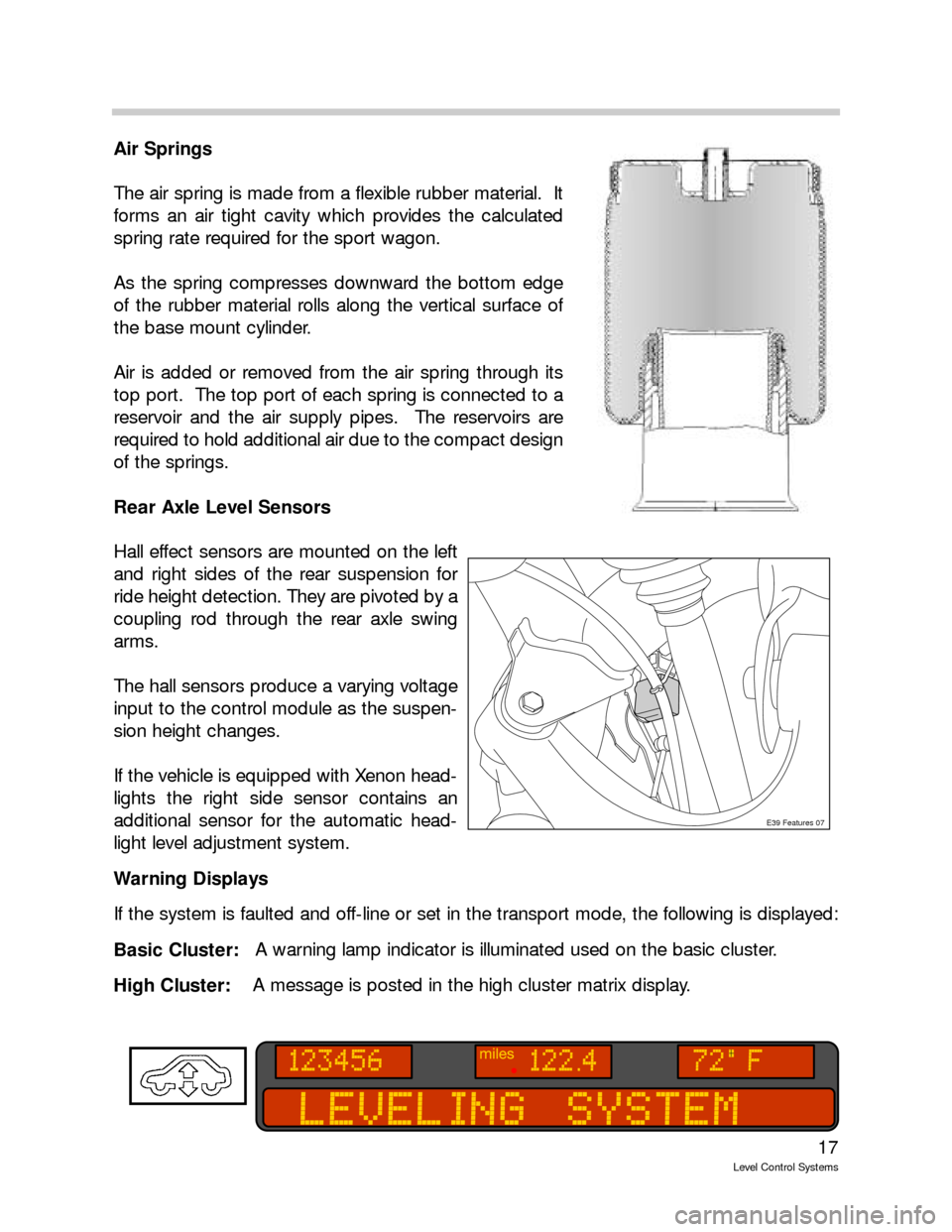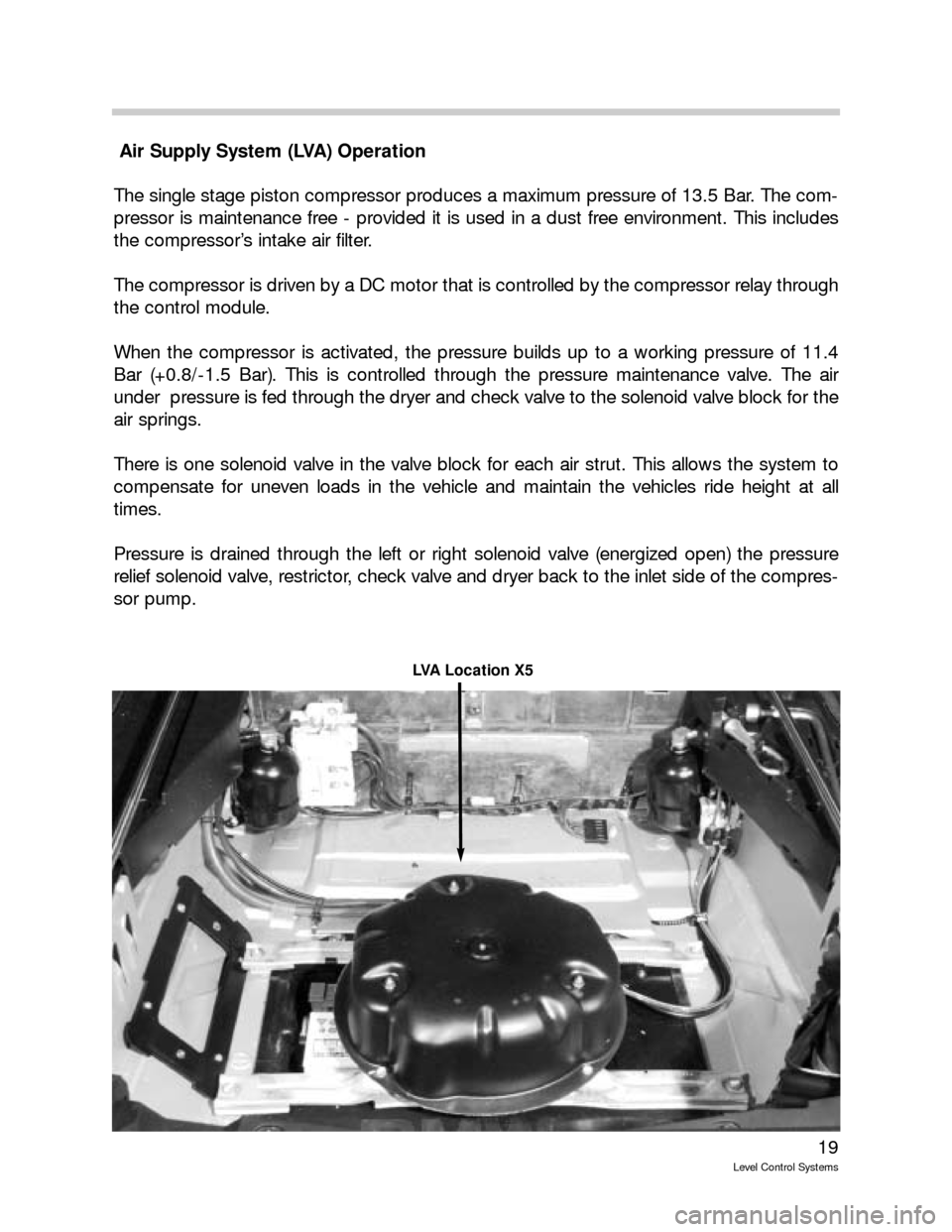Page 17 of 57

17
Level Control Systems
Air Springs
The air spring is made from a flexible rubber material. It
forms an air tight cavity which provides the calculated
spring rate required for the sport wagon.
As the spring compresses downward the bottom edge
of the rubber material rolls along the vertical surface of
the base mount cylinder.
Air is added or removed from the air spring through its
top port. The top port of each spring is connected to a
reservoir and the air supply pipes. The reservoirs are
required to hold additional air due to the compact design
of the springs.
Rear Axle Level Sensors
Hall effect sensors are mounted on the left
and right sides of the rear suspension for
ride height detection. They are pivoted by a
coupling rod through the rear axle swing
arms.
The hall sensors produce a varying voltage
input to the control module as the suspen-
sion height changes.
If the vehicle is equipped with Xenon head-
lights the right side sensor contains an
additional sensor for the automatic head-
light level adjustment system.
Warning Displays
If the system is faulted and off-line or set in the transport mode, the following is displayed:
Basic Cluster:A warning lamp indicator is illuminated used on the basic cluster.
High Cluster: A message is posted in the high cluster matrix display.
E39 Features 07
Page 18 of 57
18
Level Control Systems
Air Supply System (LVA)
The air supply system is identified as the LVA in the diagnosis program and in the repair
manual. It is mounted in the spare tire well compartment. The components are housed in
a sound deadening carrier, through rubber bushings, to prevent operating noises from
being transmitted through the vehicle’s interior.
With the exception of the compressor relay, individual replacement parts for the air supply
system are not available. If diagnosis determines a defect in any of the other air system
components, complete replacement is necessary.
The air supply system consists of the following components:
Compressor assembly with;
- Piston compressor
- Electric motor
- Air dryer (desiccator)
- Pressure relief solenoid valve
- Pressure maintenance valve
- Check valves
Compressor Relay (Replaceable)
Solenoid Valve Block (2 - two way
valves)
Lines - including distributor
E39 Features 05
Page 19 of 57

19
Level Control Systems
Air Supply System (LVA) Operation
The single stage piston compressor produces a maximum pressure of 13.5 Bar. The com-
pressor is maintenance free - provided it is used in a dust free environment. This includes
the compressor’s intake air filter.
The compressor is driven by a DC motor that is controlled by the compressor relay through
the control module.
When the compressor is activated, the pressure builds up to a working pressure of 11.4
Bar (+0.8/-1.5 Bar). This is controlled through the pressure maintenance valve. The air
under pressure is fed through the dryer and check valve to the solenoid valve block for the
air springs.
There is one solenoid valve in the valve block for each air strut. This allows the system to
compensate for uneven loads in the vehicle and maintain the vehicles ride height at all
times.
Pressure is drained through the left or right solenoid valve (energized open) the pressure
relief solenoid valve, restrictor, check valve and dryer back to the inlet side of the compres-
sor pump.
LVA Location X5
Page 20 of 57
Page 21 of 57

21
Level Control Systems
EHC System Operation
A fully functional EHC system is controlled by one of three different modes of operation.
The operation mode is selected by the control module based on current conditions provid-
ed by the monitored input signals. The main modes of operation are:
• Pre-Run/Post-Run Mode
Normal Mode
Tailgate Mode
Two special operating modes are also included in the control module programming.
New/replacement mode(pre ZCS encoded). This mode provides basic operation.
Transport Mode - Transport mode is set at the factory and raises the vehicle 30mm to
prevent vehicle damage during transportation. It must be deactivated with the DIS/
MoDiC prior to customer delivery.
Pre-Run / Post-Run Mode
The Pre-Run mode is activated when the vehicle is parked and the control module is in the
sleep mode. Opening a door or the tailgate initiates a system wake up and the control mod-
ule comes on-line.
The control module performs a self-check of the control electronics and sensors. If no fault
is found, the system will check the ride height and institute a rapid regulation if the height
varies by more than 40mm.
Page 22 of 57
22
Level Control Systems
Normal Mode Operation
Once the rear lid is closed, KL 15 switched ON and the engine started, the system switch-
es into the normal operation mode. In the normal mode, the control module will constantly
monitor the input signals from the ride height sensors and will activate a correction if the
ride height deviates by at least 10mm.
Tailgate Operating Mode
The tailgate operating mode is activated if the gate is opened with KL - 15 On and the
engine running. The difference between this mode and the normal operating mode is the
response time is rapid instead of slow .
Page 23 of 57

23
Level Control Systems
Special Operating Modes
Assembly Line Mode (New control module)
The assembly line mode refers to control module manufacturing. New control modules
are stored in a deactivated state. The control programming is not active and must first
be ZCS encoded.
After installing a replacement control module, it must be coded using the DIS or MoDiC.
The instrument cluster fault display will remain illuminated until the control module is
coded.
Transport Mode
The vehicle rolls off the factory assembly line with the EHC control module in the trans-
port mode. The transport mode inflates the air springs to a higher position (approx.
30mm higher) than the normal mode in order to avoid damage during transit.
The system will not respond to any inputs that would alter the height of the vehicle. The
fault indicator (base cluster) is illuminated or instrument cluster matrix display (high clus-
ter) provides the message “Leveling System” to draw attention to the transport mode
setting.
The Service Functions section of the diagnosis program is used to activate/deactivate
the transport mode. Once the transport mode is deactivated, check the vehicle Ride
Height Offset making sure the vehicle rear axle height is to specification.
Control Interrupts
Cornering
To prevent unnecessary suspension adjustments while driving through corners, a “control
interrupt” is built into the system. Above 30MPH the control module monitors the left/right
ride height sensors for a difference of 30mm. Exceeding this difference will put the system
into a control interrupt and no adjustment will take place. The control interrupt last for a
duration of 5 minutes.
Vehicle Lifting
The ride height control is interrupted when the vehicle is raised on a lift or with a jack. The
system monitors the ride height sensor inputs and when the height limit of 90 mm is
exceeded, the control is switched OFF until the vehicle is lowered again.
Page 24 of 57
24
Level Control Systems
EHC Service Information
Diagnosis/Coding
The EHC control module is connected to the diagnostic link. The EHC control module
activates the fault display in the instrument cluster to alert the operator of the off-line sta-
tus of the system. The EHC control module stores up to three electrical/electronic
faults.
Diagnosis/troubleshooting of EHC is carried out using the fault symptom troubleshoot-
ing program of the MoDiC or DIS. The EHC system has an extensive diagnosis program.
Replacement control modules are shipped in the factory mode. The control modules
must be ZCS encoded using the DIS or MoDiC to activate the operating parameters.